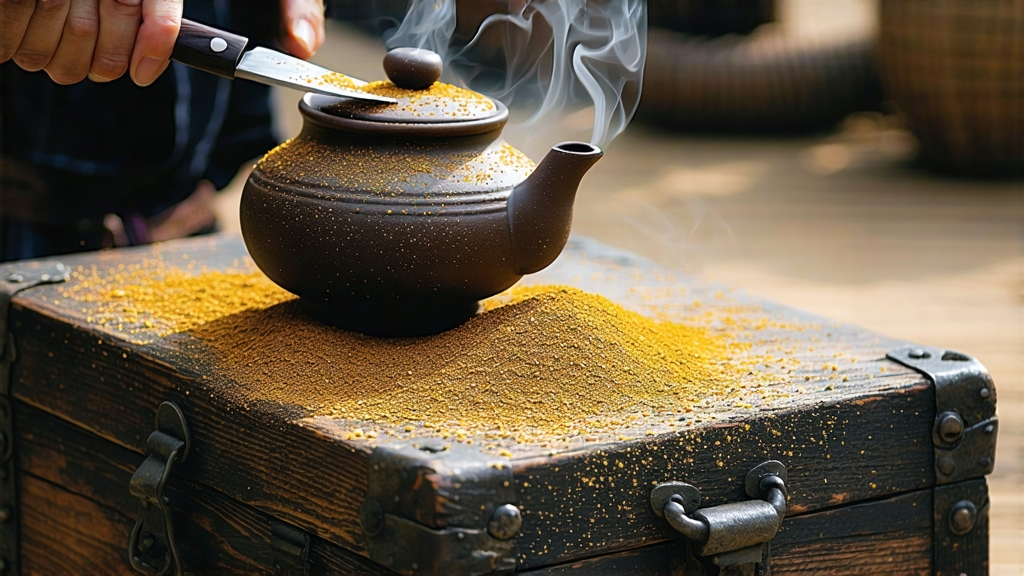
Among the six great chromatic families of Chinese tea, dark tea—hei cha—has always been the most itinerant. Compressed into bricks, cakes, or nests, it once traveled farther than any leaf before airplanes existed, nourishing caravans, monasteries, and marketplaces from Sichuan to Lhasa, Samarkand to St. Petersburg. Within this family, Fu brick tea from Hunan province carries the most romantic passport: it was literally born on the hoofprints of the Silk Road, and it carries living proof of its journey in the form of microscopic golden spores that bloom spontaneously during production. To international drinkers who equate “fermentation” with pungent barnyard flavors, Fu brick offers a gentle re-education: here is a tea that smells of chestnut and dried apricot, finishes like cocoa, and grows mellower every decade it is allowed to breathe.
Historical footprints
The story begins in the 1360s, when the Ming court replaced Yunnanese pu-erh with Hunanese dark tea to supply the frontier armies stationed along the Great Wall. Tea was pressed into long, narrow bricks nicknamed “Fu” because the imperial stamp on each brick bore the character fu—meaning “blessing” or “good fortune.” Traders soon discovered that the bricks improved after a humid summer in the saddlebags of mule caravans heading west. By the Qing dynasty, Fu brick had become the currency of the Tibetan horse-tea trade: one brick could buy one warhorse, and a caravan carried up to three thousand bricks lashed to yak saddles. The bricks absorbed yak butter, campfire smoke, and Himalayan mist, emerging a year later with a mellow, malty sweetness that monks praised as “liquid meditation.”
Terroir and leaf
Authentic Fu brick is still made only in the small county of Anhua, Hunan, where the Zi River cuts through a granite canyon laced with humid subtropical cloud. The local cultivar, Yun-Tai large-leaf, possesses unusually thick cell walls rich in pectin and soluble sugars—ideal fodder for microbial fermentation. Farmers pick one bud with four leaves in late May, after the spring rains have swollen the shoots but before the monsoon arrives. The leaves must be tough enough to withstand sixty days of piling yet tender enough to release nectar-like sweetness when brewed.
Crafting the golden flower
Production follows a choreography unchanged since the Jiaqing era. First the leaves are withered on bamboo racks set above pine-fired braziers, acquiring a whisper of smoke. They are then pan-fired at 280 °C for exactly ninety seconds to arrest oxidation while preserving leaf enzymes. What happens next distinguishes Fu brick from every other dark tea: wet piling. The leaves are sprayed with mineral-rich spring water, heaped into 1.5-meter windrows, and covered with hemp cloth. Inside this compost-like mound the temperature climbs to 55 °C, triggering a bloom of Eurotium cristatum, a harmless mold that appears as tiny golden specks—hence the local nickname “golden flowers.” Masters turn the pile every five days, listening for the rustle that indicates moisture equilibrium; when the sound shifts from a damp sigh to a crisp crackle, the pile is broken and the leaves sun-dried on raised bamboo trays. Finally the tea is steamed, pressed into iron molds, and left to cure for ninety days in an underground limestone cave whose relative humidity hovers at 75 %. The cave air is so saturated with spores that new bricks begin to freckle within a week.
Decoding the brick
A well-aged Fu brick weighs exactly 1.125 kg and measures 35 × 18 × 4 cm—dimensions calculated so that seven bricks form a cylindrical load matching the girth of a yak’s flank. The surface is matte chocolate with amber mottling; when broken, it reveals a labyrinth of golden veins that glitter like mica. The aroma is a layered chord: dried persimmon, pinewood smoke, and a faint note of blue cheese that signals healthy mold activity. Internationally, Fu brick is sold both as whole bricks and as loose “broken flower” grade; purists prefer the brick because compression slows oxidation and allows the golden flowers to continue metabolizing sugars for decades.
How to brew it without a yak butter churn
Fu brick forgives almost every brewing sin except scalding inactivity. Begin by warming a Yixing clay teapot with 95 °C water; clay buffers temperature and absorbs smoke. Using a